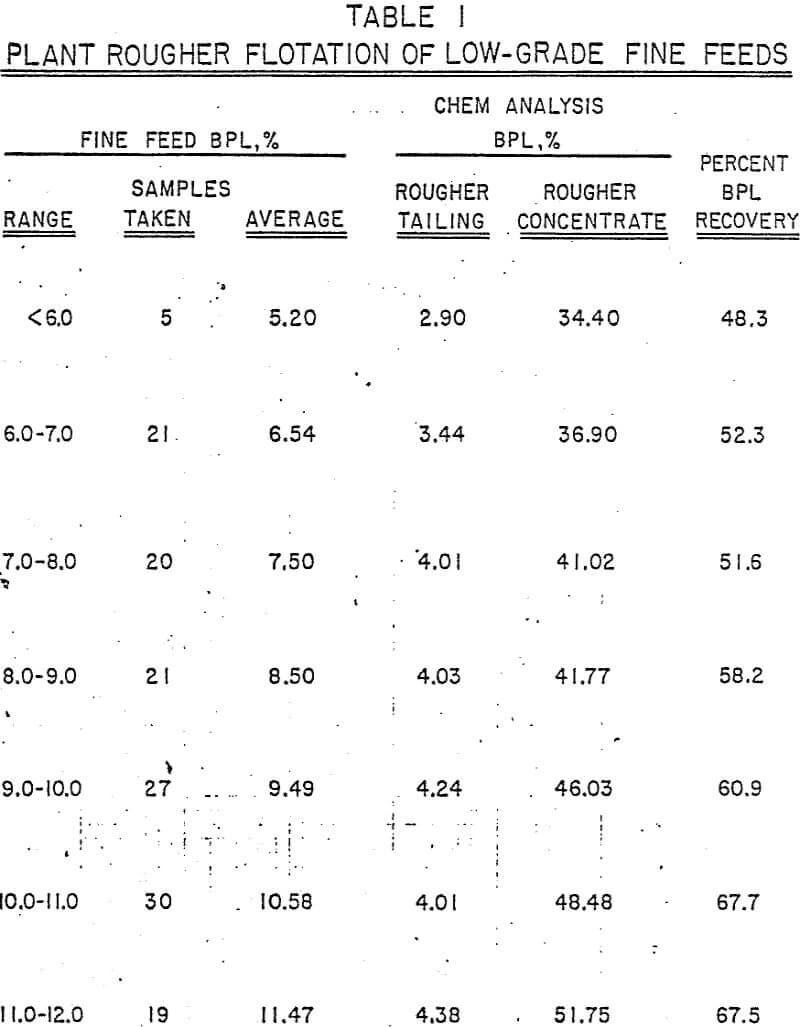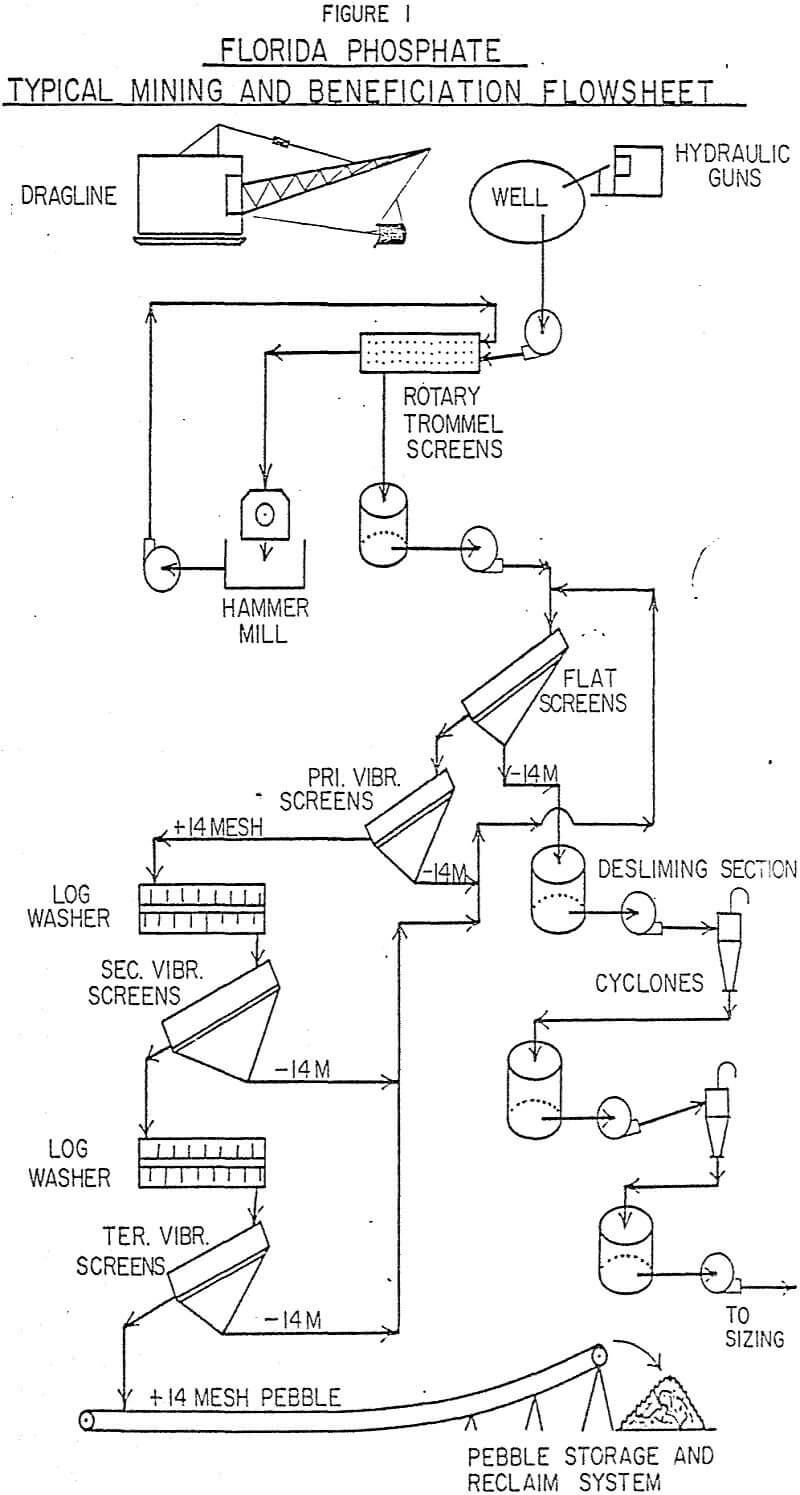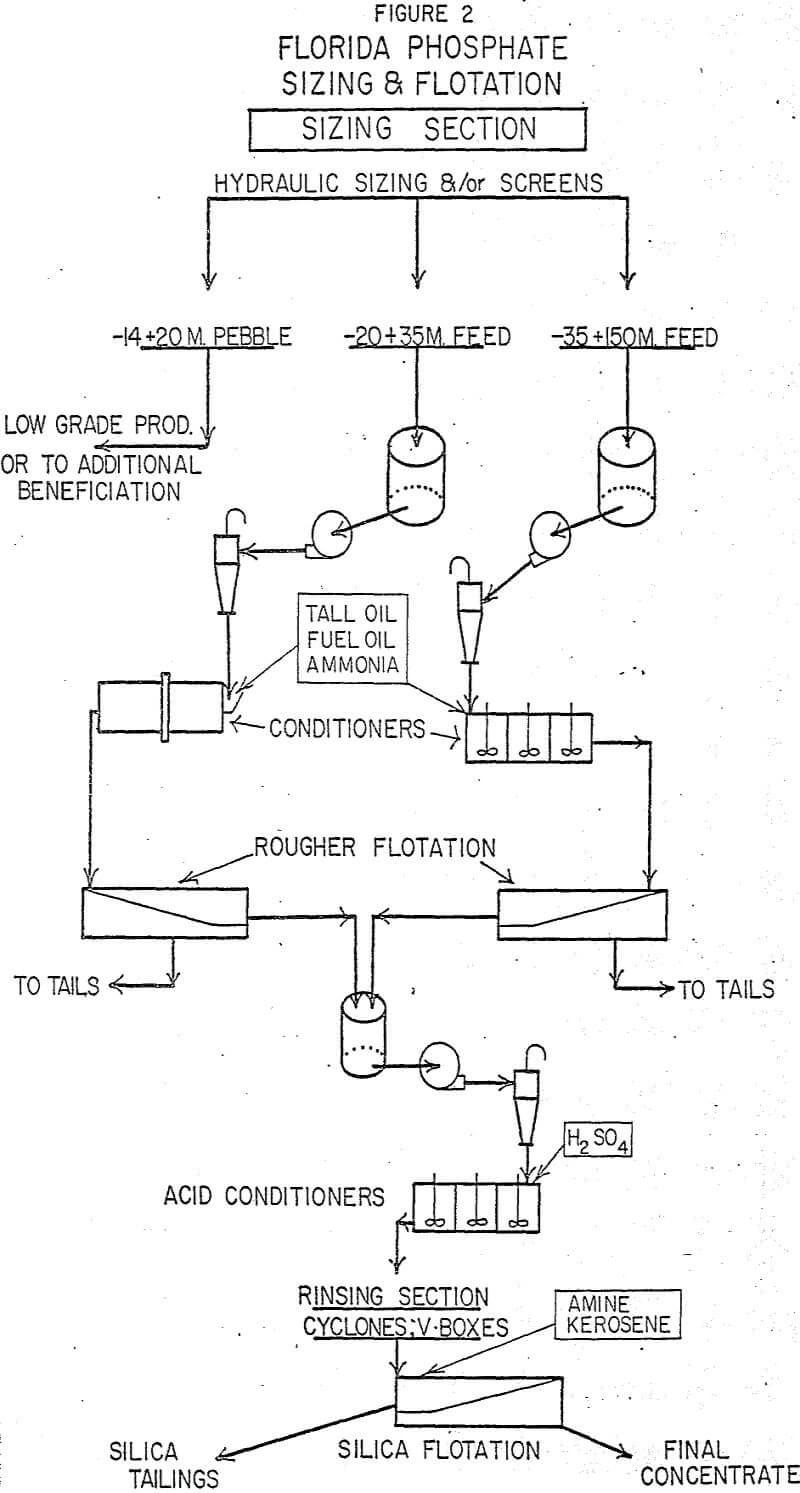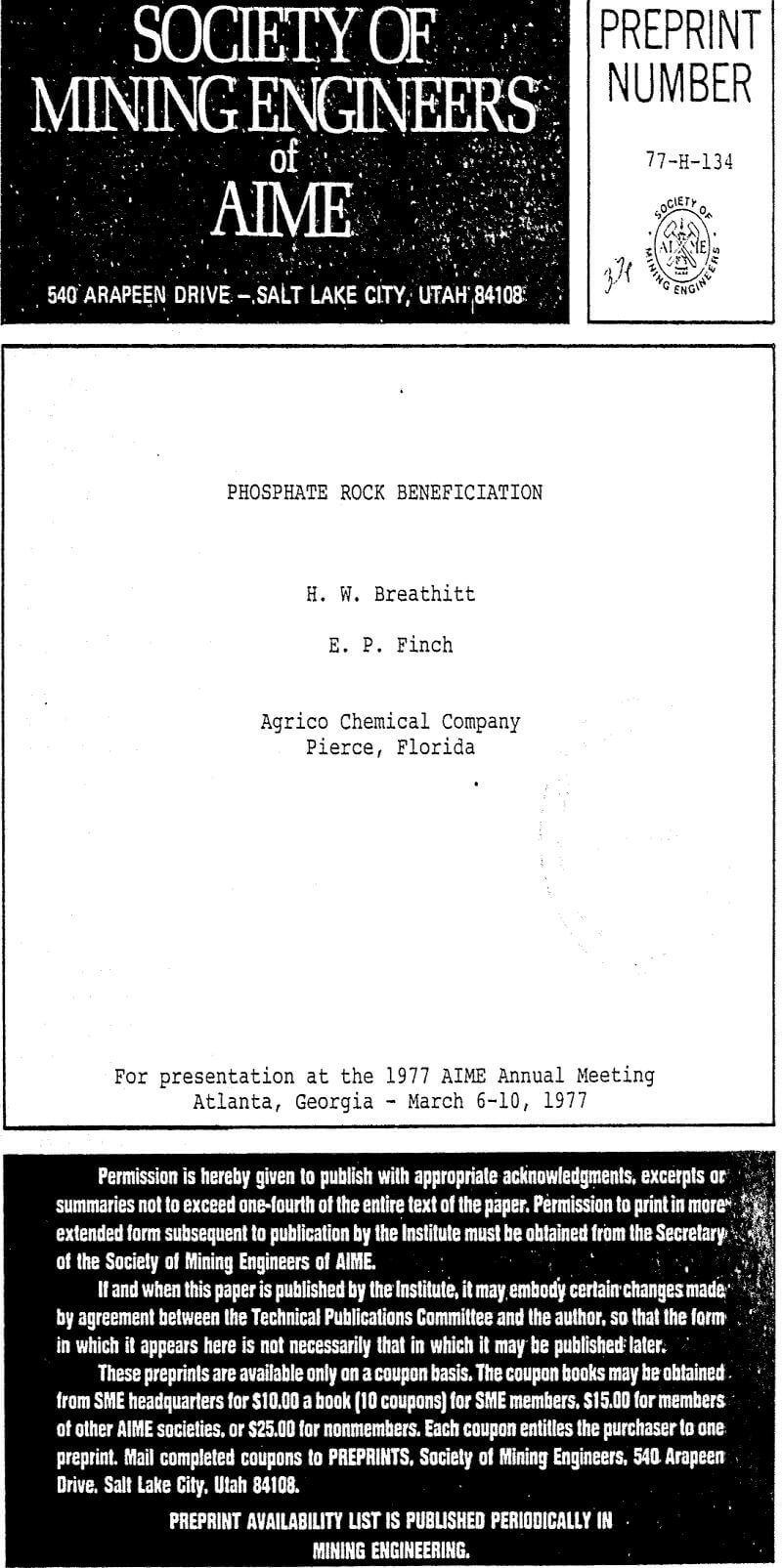Table of Contents
Many new mines overseas have also become significant. This includes countries such as Senegal, Togo, Israel, Spanish Sahara, and Jordan. Limited production, often as by-products, has been noted in South Africa, Brazil, and other countries. In recent years, and even recent months, we have learned of many new areas being considered as potential sources of phosphate rock. This includes Australia, Saudi Arabia, Mexico, Colombia, and Brazil. Many other developing countries have discoveries and are considering their new deposits, often with difficult beneficiation problems, as potential sources of phosphate.
Florida Phosphates
Florida phosphate occurs in a sand-clay matrix overlaid by unconsolidated overburden of sand and sandy clays, ranging from 10 feet to 45 feet in depth. The matrix usually occurs in fairly horizontal and continuous beds ranging from 3 feet to 25 feet in thickness, and is composed of clay minerals from the montmorillonite family, silica sand, and phosphate particles from ¾” to 200 mesh. The particles coarser than 14 mesh are referred to as “pebble phosphate” while the particles finer than 14 mesh are referred to as flotation feed.
As with most of the mining industry in general, the trend in Florida is toward mining of leaner deposits. Some of the factors associated with leaner deposits and with today’s economic conditions are listed following.
- High ratios of overburden to matrix; dictated in part by thinner beds of matrix.
- High ratios of matrix to finished product; dictated in part by lower-grade matrix.
- High ratios of flotation feed to pebble in some areas; associated with increased capital and operating costs needed to produce the more expensive flotation products.
Fort Green Mine
Agrico’s Fort Green Mine is located in the southwest corner of Polk County and is directly adjacent to Manatee, Hillsborough, and Hardee Counties. The washer began operation in the spring of 1975, while the recovery plant started up 9 months later. With some minor differences, Fort Green is typical of a modern Central Florida plant. Rated capacity is 3,000,000 plus tons of product per year.
Briefly, slurried matrix is pumped to rotary trommel screens, 7/8 inches, for washing; the trommel oversize is sent to hammermills where it is crushed and returned to the trommel screens, or pumped to tailings if minor impurities (Fe2O3, Al2O3, MgO) are high. The trommel undersize is pumped to 14 mesh stationary flat screens. The flat screen oversize is subjected to three stages of 14 mesh vibrating screening and two stages of logwashing in order to produce a final pebble product. The flat screen undersize is pumped to two stages of cyclone desliming (150 mesh) prior to sizing.
In actuality, Fort Green was designed to accept feeds from two distinct mining areas simultaneously a “pebble rich” area associated with low-grade flotation feeds and a “pebble-lean” area associated with higher-grade flotation feeds. Because of the staggered start-up (washer first, recovery plant later), draglines were placed in the pebble rich areas.
Jordan Phosphates
Phosphate was first discovered in Jordan at the turn of the present century during the excavation of railroad cuts in the Ruseifa and El Hassa areas. In 1977 these two areas are still the sites of the total present phosphate mining in Jordan. Underground mining methods were used at both sites in the past but currently all mining is open pit.
The phosphate deposits cover an estimated 60% of the country and are located in the upper Cretaceous and Eocene formations. Potential reserves have been estimated at two billion tons. Over 300 million tons of reserves have been confirmed and drilling of new areas continues to confirm improvements in their reserve picture. It is interesting to note the publication of a map by Jordan Phosphate Mines Co., Ltd.
Ruseifa, the first mine site in Jordan, is only a short drive northeast of Amman. The newest open pit mining operation, which has been expanded considerably in the 1975-1976 period, is over two hours drive south of Amman over the desert highway. This site, called El Hassa, is located in a very arid, treeless country closely resembling desert country in the southwestern United States.
The basic mining process is as follows:
- Drill and shoot the overburden. The overburden is loaded into trucks by large front-end loaders and moved from the mining area.
- The ore zone is then ripped by D-9 bulldozers, pushed into piles with a blade and loaded into trucks by front-end loaders.
- The protore-ore mixture is truck hauled and dumped into a nearby crushing station.
- After dumping on a 6″ grizzly, the +6″ fraction is sent to “reject” piles.
- The minus 6″ material passes through a large impact crusher.
- The crusher discharge then goes to a double deck vibrating screen (2″ and ¼” decks), with the total plus ¼” fraction passing to “reject” piles.
- The minus ¼” fraction is conveyed by belt to the central processing plant.
Brazil Phosphates
The Catalao pipe is most interesting. This deposit is located some 18 kilometers northeast of the town of Catalao. Catalao itself is on the main highway from Sao Paulo to the capitol at Brasilia and is actually some 3% hours drive south of Brasilia. The magmatic deposit at Catalao consists of red, earthy-clay materials with inclusions of massive formations of magnetite and apatite. The overburden ranges from 20 to 40 meters in depth and the ore from 20 to 35 meters in thickness. Ore grades range from 12% P2O5 to 22% P2O5. Mining is planned by open pit methods at Fosfago.
In actual operation, the +10 mesh magnetite fraction will be stockpiled separately from the tailing. Note that the rod mill was in closed circuit with a screw classifier for the 65 mesh grind.
The commercial operation by Fosfago will be quite similar to the pilot operations with some changes in equipment. The milling stages will include impact crushers, rod, and ball mills. Primary magnetic separation will be made at 10 mesh followed by a secondary magnetic separation after finer grinding. Desliming will be accomplished in high pressure 4″ hydrocyclones. Double-paddle attrition scrubbers will also be used. Flotation will be accomplished in 300 cubic foot cells which will include a rougher and two cleaner units. The apatite concentrates will go to a thickener with the thickened underflow being pumped to a remote location, which will include a smaller thickener, belt filter, and dryer. Rail loading from dry storage silos will be accomplished at this point.
North Carolina Phosphates
The present phosphate deposit being mined in eastern North Carolina is located near Aurora, not far from Washington, N. C. The city of Washington is located directly on the Pamlico River which in turn empties into Pamlico Sound in the vicinity of Cape Hatteras. Geologists indicate this marine sedimentary deposit was formed in the Miocene seas along the Atlantic Coastal Plain some 15 million years ago.
Compared to most Florida deposits currently being mined, this matrix disintegrates readily with water on the washer. Feed grades are generally very good in this area, often containing 17-18%, after “desliming.” After removing the pebble on vibrating screens, the clay fractions are discarded as overflows from hydrocyclone sand report to thickeners where recycle water is reclaimed to return to the processing plant, and the clays sent to impounding areas. Clays in North Carolina settle very rapidly as compared to most Florida clays.




